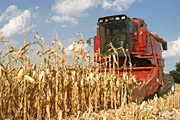- Number 321 |
- September 27, 2010
Corn cob storage study could lead to more efficient biofuel production
INL researchers are studying
Iowa and South Dakota corn
cobs to develop harvest and
storage techniques that help
make biofuel production
more efficient.
Corn cobs that once had limited uses are becoming a valuable precursor to renewable fuels, and researchers at DOE's Idaho National Laboratory are helping develop the logistical know-how to get cobs from fields to the biorefinery.
In partnership with the Department of Energy’s Office of the Biomass Program (DOE-OBP), a consortium that includes several equipment manufacturers, farmers, ethanol producer POET and INL have worked together to establish the largest corn cob storage study of its kind. The study includes roughly 2,400 tons of loose cobs harvested in 2009 from around 3,500 acres of farmland in the Emmetsburg, Iowa, area and more than 800 direct-baled large square bales harvested from about 500 acres in the Hurley, S.D., area.
INL researchers are monitoring temperature, moisture and compositional degradation within varied bales and piles. The researchers’ findings will help POET, farmers, equipment manufacturers and others in the emerging corn cob biofuels industry understand how best to harvest and store the feedstock.
POET is working with a number of farmers who may be supplying cobs to one of the nation’s first commercial-scale cellulosic biorefineries. The firm also is consulting with major agricultural equipment manufacturers eyeing the cob harvesting market. Better cob storage information could impact them all.
The current study continues through September 2010 with a follow-up study planned for the 2010 harvest season.
[Nicole Stricker, 208.526.5955,
nicole.stricker@inl.gov]

